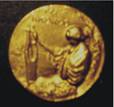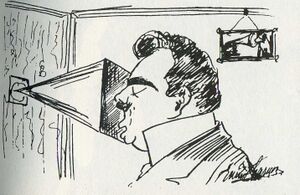إنريكو كاروسو
إنريكو كاروسو Enrico Caruso | |
|---|---|
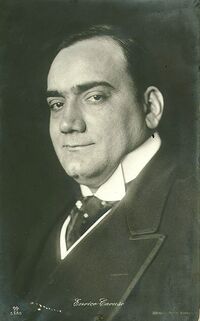 Caruso circa 1910 | |
| وُلِدَ | 25 فبراير 1873 |
| توفي | 2 أغسطس 1921 (aged 48) ناپولي، مملكة إيطاليا |
| المثوى | Cimitero di Santa Maria del Pianto |
| المهنة | تينور أوپرالي |
| سنوات النشاط | 1895–1920 |
| الزوج | |
| الشريك | Ada Giachetti (1898–1908) |
| الأنجال | 5 |
| التوقيع | |
إنريكو كاروسو ( Enrico Caruso ؛ /kəˈruːzoʊ/,[1] /USalsokəˈruːsoʊ/,[2][3][4] النطق بالإيطالية: [enˈriːko kaˈruːzo]؛ 25 فبراير 1873 – 2 أغسطس 1921) كان تينور أوپرالي إيطالي. He sang to great acclaim at the major opera houses of Europe and the Americas, appearing in a wide variety of roles (74) from the Italian and French repertoires that ranged from the lyric to the dramatic. One of the first major singing talents to be commercially recorded, Caruso made 247 commercially released recordings from 1902 to 1920,[5] which made him an international popular entertainment star.
السيرة
النشأة

جاء إنريكو كاروسو من خلفية فقيرة وإن لم تكن مُعدَمة. وُلِد في ناپولي في the via Santi Giovanni e Paolo n° 7 في 25 فبراير 1873، وقد عُمِّد في اليوم التالي في كنيسة سان جوڤاني إ پيديمونتى داليفى المجاورة (المسماة الآن پيديمونتى ماتيزى)، في مقاطعة كازرتا في كامپانيا، جنوب إيطاليا. [6]
السيرة المهنية المبكرة
أوپرا متروپوليتان
Medal that Caruso gave to Pasquale Simonelli,[7] his New York City impresario
Reverse: Euterpe, muse of music, with lyre
الابتزاز من اليد السوداء
المرض والوفاة

On 16 September 1920, Caruso concluded three days of recording sessions at Victor's Trinity Church studio in Camden, New Jersey. He recorded several discs, including the Domine Deus and Crucifixus from the Petite messe solennelle by Rossini. These recordings were to be his last.
Dorothy Caruso noted that her husband's health began a distinct downward spiral in late 1920 after he returned from a lengthy North American concert tour. In his biography, Enrico Caruso Jr. points to an on-stage injury suffered by Caruso as the possible trigger of his fatal illness. A falling pillar in Samson and Delilah on 3 December had hit him on the back, over the left kidney (and not on the chest as popularly reported).[8] A few days before a performance of Pagliacci at the Met (Pierre Key says it was 4 December, the day after the Samson and Delilah injury) he suffered a chill and developed a cough and a "dull pain in his side". It appeared to be a severe episode of bronchitis. Caruso's physician, Philip Horowitz, who usually treated him for migraine headaches with a kind of primitive TENS unit, diagnosed "intercostal neuralgia" and pronounced him fit to appear on stage, although the pain continued to hinder his voice production and movements.
رپرتوار
Caruso's operatic repertoire consisted primarily of Italian works along with a few roles in French. He also performed two German operas, Wagner's Lohengrin and Goldmark's Die Königin von Saba, singing in Italian, early in his career. Below are the first performances by Caruso, in chronological order, of each of the operas that he undertook on the stage. World premieres are indicated with **.
- L'amico Francesco (Morelli) – Teatro Nuovo, Napoli, 15 March 1895 (debut)**
- Faust – Caserta, 28 March 1895
- Cavalleria rusticana – Caserta, April 1895
- Camoens (Musoni) – Caserta, May 1895
- Rigoletto – Napoli, 21 July 1895
- La traviata – Napoli, 25 August 1895
- Lucia di Lammermoor – Cairo, 30 October 1895
- La Gioconda – Cairo, 9 November 1895
- Manon Lescaut – Cairo, 15 November 1895
- I Capuleti e i Montecchi – Napoli, 7 December 1895
- Malia (Francesco Paolo Frontini) – Trapani, 21 March 1896
- La sonnambula – Trapani, 25 March 1896
- Mariedda (Gianni Bucceri) – Napoli, 23 June 1896
- I puritani – Salerno, 10 September 1896
- La Favorita – Salerno, 22 November 1896
- A San Francisco (Sebastiani) – Salerno, 23 November 1896
- Carmen – Salerno, 6 December 1896
- Un Dramma in vendemmia (Fornari) – Napoli, 1 February 1897
- Celeste (Marengo) – Napoli, 6 March 1897**
- Il Profeta Velato (Napolitano) – Salerno, 8 April 1897
- La bohème – Livorno, 14 August 1897
- La Navarrese – Milano, 3 November 1897
- Il Voto (Giordano) – Milano, 10 November 1897**
- L'arlesiana – Milano, 27 November 1897**
- Pagliacci – Milano, 31 December 1897
- La bohème (Leoncavallo) – Genova, 20 January 1898
- The Pearl Fishers – Genova, 3 February 1898
- Hedda (Leborne) – Milano, 2 April 1898**
- Mefistofele – Fiume, 4 March 1898
- Sapho (Massenet) – Trento, 3 June (?) 1898
- Fedora – Milano, 17 November 1898**
- Iris – Buenos Aires, 22 June 1899
- La regina di Saba (Goldmark) – Buenos Aires, 4 July 1899
- Yupanki (Berutti)– Buenos Aires, 25 July 1899**
- Aida – St. Petersburg, 3 January 1900
- Un ballo in maschera – St. Petersburg, 11 January 1900
- Maria di Rohan – St. Petersburg, 2 March 1900
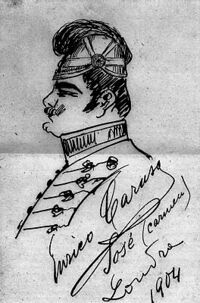
- Manon – Buenos Aires, 28 July 1900
- Tosca – Treviso, 23 October 1900
- Le maschere (Mascagni) – Milano, 17 January 1901**
- L'elisir d'amore – Milano, 17 February 1901
- Lohengrin – Buenos Aires, 7 July 1901
- Germania – Milano, 11 March 1902**
- Don Giovanni – London, 19 July 1902
- Adriana Lecouvreur – Milano, 6 November 1902**
- Lucrezia Borgia – Lisbon, 10 March 1903
- Les Huguenots – New York, 3 February 1905
- Martha – New York, 9 February 1906
- Madama Butterfly – London, 26 May 1906
- L'Africana – New York, 11 January 1907
- Andrea Chénier – London, 20 July 1907
- Il trovatore – New York, 26 February 1908
- Armide – New York, 14 November 1910
- La fanciulla del West – New York, 10 December 1910**
- Julien – New York, 26 December 1914
- Samson et Dalila – New York, 24 November 1916
- Lodoletta – Buenos Aires, 29 July 1917
- Le prophète – New York, 7 February 1918
- L'amore dei tre re – New York, 14 March 1918
- La forza del destino – New York, 15 November 1918
- La Juive – New York, 22 November 1919
Caruso also had a repertory of more than 500 songs. They ranged from classical compositions to traditional Italian melodies and popular tunes of the day, including a few English-language titles such as George M. Cohan's "Over There", Henry Geehl's "For You Alone" and Arthur Sullivan's "The Lost Chord".
تسجيلات
Caruso possessed a phonogenic voice which was "manly and powerful, yet sweet and lyrical", to quote the singer/author John Potter (see bibliography, below). He became one of the first major classical vocalists to make numerous recordings. Caruso and the disc phonograph, known in the United Kingdom as the gramophone did much to promote each other in the first two decades of the 20th century. Many of Caruso's recordings have remained continuously available since their original issue over a century ago, and all of his surviving recordings (including several unissued takes) have been remastered and reissued several times over the years. Although recordings of complete operas have been available since the early 1900s, (Carmen in 1908 for example), Caruso never participated in a complete opera recording.[9]
عينات صوتية
- 3:05"O Mimì, tu più non torni" with Antonio Scotti as Marcello from La bohème (1907)
- 4:22"Una furtiva lagrima" from Donizetti's L'elisir d'amore (1911)
- 4:11"Manon! avez-vous peur ... On l'appelle Manon" from Massenet's Manon (1912)
- 3:46"È scherzo od è follia", from Verdi's Un ballo in maschera, with Frieda Hempel, Maria Duchêne, Andrés de Segurola and Léon Rothier (1914)
- 4:09"O souverain, O juge, O père!" from Massenet's Le Cid (1916)
انظر أيضاً
- Birth of public radio broadcasting
- Caruso sauce
- The Young Caruso 1951 Italian film
- The Great Caruso, 1951 US film
- Caruso-Kronenboden-Collection, Berlin, Caruso sings again
الهامش
- ^ قالب:Cite Oxford Dictionaries
- ^ "Caruso". The American Heritage Dictionary of the English Language (5th ed.). HarperCollins. Retrieved 29 July 2019.
- ^ "Caruso". Collins English Dictionary. HarperCollins. Retrieved 29 July 2019.
- ^ قالب:Cite Merriam-Webster
- ^ "CARUSO, Enrico: Complete Recordings, Vol. 10 (1916-1917)". Classical Music - Streaming Classical Music. 14 August 2003. Retrieved 31 July 2020.
- ^ Caruso Jr & Farkas 1990, p. 18.
- ^ Pasquale J., Simonelli (2012). Enrico Caruso Unedited Notes. Sacer Equestris Aureus Ordo. ISBN 978-0615714905.
- ^ Caruso, Jr.'s biography devotes an entire section to medical opinions concerning the tenor's ailments and possible causes of his death.
- ^ "Carmen. The first complete recording. Liner Notes by Harold Bruder". Marston Records. Archived from the original on 30 July 2013. Retrieved 29 July 2013.
المراجع
- Caruso, Dorothy (1945). Enrico Caruso: His Life and Death. discography by Jack Caidin. New York: Simon and Schuster.
- Caruso Jr, Enrico; Farkas, Andrew (1990). Enrico Caruso: My Father and My Family. discography by William Moran, chronology by Tom Kaufman. Portland: Amadeus Press.
- Jackson, Stanley (1972). Caruso. New York: Stein and Day.
- Key, Pierre Van Rensselaer; Zirato, Bruno (1922). Enrico Caruso, a Biography. Boston: Little, Brown and Co.
- Scott, Michael (1991), The Great Caruso, Random House, ISBN 978-0-517-06766-6
وصلات خارجية
- أعمال من Enrico Caruso في مشروع گوتنبرگ
- Works by إنريكو كاروسو at LibriVox (public domain audiobooks)

- Works by or about إنريكو كاروسو at Internet Archive
- Complete Thesis of Jean-Pierre Mouchon "Enrico Caruso. The Man and the Artist" (Terra Beata, 45, bd. Notre-Dame, 13006. Marseille, France, 2011, 1359 p. ill. ISBN 2-909366-16-2)
- Caruso, Enrico and Luisa Tetrazzini: Caruso and Tetrazzini on the Art of Singing (1909), complete text at Project Gutenberg
- "Caruso and the San Francisco Earthquake" San Francisco Museum
- Enrico Caruso recordings at the Discography of American Historical Recordings.
- Enrico Caruso at the Internet Movie Database
- The Enrico Caruso Museum of America
- The Enrico Caruso Page
- Enrico Caruso – Sound Clips and Narration at History of the Tenor
- Recordings of Caruso Part 1, Part 2 Audio files at Internet Archive
- Video of Caruso at 1908 opening of Teatro Colon in Buenos Aires
- إنريكو كاروسو at Find a Grave
- Simonelli, Pasquale (2012), Enrico Caruso Unedited Notes, Charleston, SC.: S.E.A.O. Inc. ISBN 978-0615714905
- Newspaper clippings about إنريكو كاروسو in the 20th Century Press Archives of the ZBW
- Short description is different from Wikidata
- Biography with signature
- Articles with hatnote templates targeting a nonexistent page
- إنريكو كاروسو
- مواليد 1873
- وفيات 1921
- 1906 San Francisco earthquake survivors
- 19th-century Italian male singers
- 20th-century Italian male opera singers
- مقالات تحتوي مقاطع ڤيديو
- Burials in Italy
- Deaths from peritonitis
- Grammy Lifetime Achievement Award winners
- Italian emigrants to the United States
- Italian operatic tenors
- Musicians from Naples
- Victor Records artists

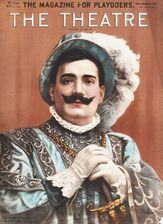
![Medal that Caruso gave to Pasquale Simonelli,[7] his New York City impresario](/w/images/thumb/7/79/CarusoO.jpg/191px-CarusoO.jpg)
